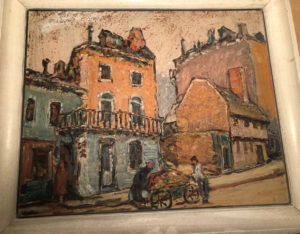“The Cabbage Vendor” – an Unexpected Surprise
By: Edith Steblecki
It’s not every day that someone contacts the Paul Revere Memorial Association and offers to donate a framed painting showing two of our historic homes- the Revere and Pierce/Hichborn Houses. Needless to say, we were surprised and delighted when this occurred in late 2020. The painting in question was exhibited in 1971 and is titled “The Cabbage Vendor.” While our focus is, of course, on the houses, it is interesting that the artist is calling out the action in the street: two people, one presumably buying a cabbage from the other, near a loaded wagon in the foreground. Although the work is unsigned, it is attributed to Russell Cheney (1881-1945), a known New England artist born in Connecticut whose works have been frequently exhibited. Margo Burns, the painting’s owner who contacted us, was familiar with Cheney’s work, having lived in the artist’s home in Kittery, Maine, for four years. She acquired the painting at auction around 2004 without knowing the location of the urban street scene it depicted. A family friend, who had worked at the Paul Revere House for many years, alerted her to the fact that Cheney had not just painted an urban vegetable cart, but also two of Boston’s oldest homes!
A website on the artist, www.russellcheney.com, details his active career. Carol Cheney, the artist’s great-niece, and Richard Candee, a well-known New England decorative arts scholar, have both done much research into his life and work. Russell Cheney studied in New York and Paris where he first exhibited his work at the age of 20. His paintings were shown regularly in such places as New York City, Maine, Philadelphia, Texas, Connecticut, Boston, Vermont, New Mexico, Southern California, and even at the Chicago “Century of Progress” Fair in 1935. He also painted in many of these places, producing varied works which were comprised of both still life subjects and exterior landscapes inspired by the locations.
Cheney’s work in Boston affords us a new depiction of our two properties, which is a real treat as it is always intriguing to see views of the houses that we have not seen before. A database of the artist’s work, which Candee is compiling, dates the painting to the early 1940s, also the era depicted in the painting. The Paul Revere House, second from the right, is shown after its 1907-1908 restoration, while the Pierce/Hichborn House appears second from the left before its 1950 restoration. The color palette is similar to another of Cheney’s works, an undated view of the Boston elevated train at Charles Street, primarily done in orange, tan/brown, and blue/green. The wooden Revere House is painted in shades of brown, while brick features are orange. Some white areas are painted blue/green. The varied thickness of the paint and pronounced brush strokes give a bold texture to the surface, while the paint on the sky is thin enough to show glimpses of the board beneath. A conservator will need to assess whether the artist intended this or if the surface is flaking and requires treatment to stabilize it.
While some details are hard to make out in the painting, the location itself is unmistakable. Photographs of the houses in this era attest to the accuracy of the scene. Rather than paint an idealized colonial streetscape, Cheney created a realistic rendering of two old houses in an immigrant neighborhood, where it was not unusual to see street vendors selling produce. The vacant lot between these two historic houses is key to dating the painting.
As built in ca. 1680, the Revere House was the middle of three rowhouses. Its neighbor on the left stood there until the 1870s, leaving a vacant lot until the 1890s when a large brick apartment building was built. In 1942, the apartment house was demolished following a fire. As a result, it was necessary to leave a brick retaining wall on the exposed side of the Revere House. This brick feature, which appears in Cheney’s painting, extended slightly above the roof and was flat on top. It was removed around 1950. The Paul Revere Memorial Association had purchased the empty lot in 1942. It now contains the museum’s visitor entry, courtyard, and gardens, enclosed by a brick wall.
On the left side of the painting behind the cabbage vendor, the brick Pierce/Hichborn House (1711) is shown before its 1950 restoration in a period in which many tenants still lived in the building. As it was a heavily lived-in residence, one can make out that the fence across the second story is a fire escape. Photographs show the street level painted white (blue in the painting). Since there was a barber shop operating out of the first floor in the 1940s, red and white strips were painted on the corner of the building, in lieu of an actual barber’s pole. This appears as short dark diagonal lines in the painting.
All of this context makes it safe to say that “The Cabbage Vendor” was painted within the last three years of Cheney’s life, sometime between 1942 and 1945. In addition to this work, he also painted other Boston and North End landmarks, such as Old North Church. More research into this new acquisition will hopefully lead us to a fuller understanding of the artist and his work.
Edith Steblecki is the Curator and Assistant Director of the Paul Revere House
For more information about Cheney’s life you can read Scott Bane’s book A Union Like Ours: The Love Story of F. O. Matthiessen and Russell Cheney, or watch the author’s recorded talk for the Massachusetts Historical Society.
Edited June 2024.

